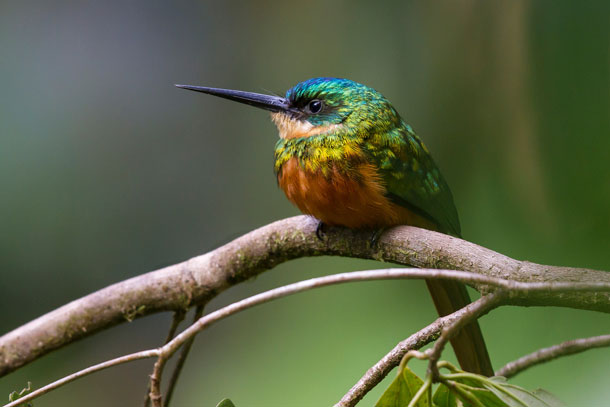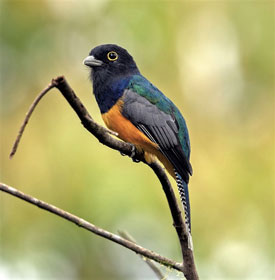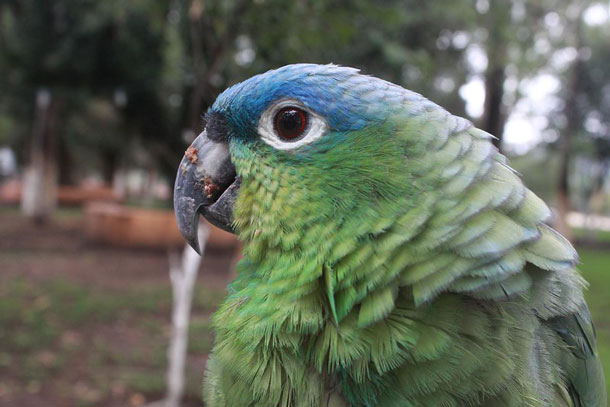BirdNote®: Green Birds and Brown Birds in the Tropical Rainforest
Air Date: Week of November 1, 2019

Rufous-tailed jacamars are striking in appearance with their iridescent, multicolored plumage. (Photo: Petr Kosina, CC)
The tropical rainforests of the world are lush habitats home to thousands of different species, and their birds have evolved a tremendous variety of adaptations, from intricate courtship rituals to massive horned bills for cracking nuts. But as BirdNote’s Michael Stein reports, most rainforests birds do have at least one thing in common: their plumage.
Transcript
CURWOOD: It’s Living on Earth, I’m Steve Curwood.
BASCOMB: And I’m Bobby Bascomb
[BIRDNOTE THEME]
Tropical rainforests are the most biodiverse terrestrial ecosystem on earth and home to some fifty percent of all the bird species in the world. Tropical birds have evolved a tremendous variety of adaptations, from intricate courtship rituals to massive horned bills for cracking nuts. But as BirdNote’s Michael Stein reports, most rainforests birds do have at least one thing in common.
BirdNote®
Green Birds and Brown Birds in the Tropical Rainforest
[Rainforest ambient]
STEIN: The canopies of the world’s tropical rainforests are green year round.
[Mealy Parrots, http://macaulaylibrary.org/audio/68674]
So are many of the birds within them, from mostly green parrots and sparkling, iridescent hummingbirds, to trogons [pronounced tro-gahnz] and jacamars [JAK-uh-mahrz], with their shiny green backs.

Male gartered trogons possess a yellow ring around their eyes that distinguishes them from other trogons. (Photo: Doug Greenberg, CC)
[Collared Trogon song, http://macaulaylibrary.org/audio/113241]
Their coloring underscores a fundamental of Darwinian evolution: “that an organism’s appearance, behavior and physiology must be adaptive to contribute to a greater overall level of reproductive success.” In other words, being green in the tropics means you won’t stand out and you have a better chance of reproducing, especially if you spend much of your time among the glossy leaves up top.
[Mealy Parrots, http://macaulaylibrary.org/audio/68674]
As for the vividly colorful birds found throughout the tropics, put them inside the forest, and their iridescent coloring becomes a dark disguise. Tropical birds that live in the shadows near the forest floor—antbirds, ovenbirds, and wrens—sport earth-tones of brown, gray, and black. Even the hummingbirds of the understory, known as hermits, wear drab plumage of gray, or brown, or only the dullest green. Camouflage almost as well suited for the deciduous forests of the north as the rainforests of the tropics.
I’m Michael Stein.

Although the mealy amazon parrot is not endangered, in some countries this bird is considered threatened due to habitat loss and the wildlife trade. (Photo: Terje Grimsgaard, CC)
Written by Bob Sundstrom
Bird sounds provided by The Macaulay Library of Natural Sounds at the Cornell Lab of Ornithology, Ithaca, New York. Mealy Parrots [68674] recorded by Paul A Schwartz; Collared Trogon recorded by Curtis A Marantz.
BirdNote’s theme music was composed and played by Nancy Rumbel and John Kessler.
Producer: John Kessler
Executive Producer: Dominic Black
© 2015 Tune In to Nature.org December 2015 Narrator: Michael Stein
https://www.birdnote.org/show/green-birds-and-brown-birds-tropical-rainforest
BASCOMB: For photos flock over to our website, loe dot org
[MUSIC: Carlos Moska, “Corcovado” on The Latin Jazz Collection, AML]
Links
Learn more about this story on the BirdNote website
Find out more about the rufous-tailed jacamar
Living on Earth wants to hear from you!
Living on Earth
62 Calef Highway, Suite 212
Lee, NH 03861
Telephone: 617-287-4121
E-mail: comments@loe.org
Newsletter [Click here]
Donate to Living on Earth!
Living on Earth is an independent media program and relies entirely on contributions from listeners and institutions supporting public service. Please donate now to preserve an independent environmental voice.
NewsletterLiving on Earth offers a weekly delivery of the show's rundown to your mailbox. Sign up for our newsletter today!
 Sailors For The Sea: Be the change you want to sea.
Sailors For The Sea: Be the change you want to sea.
 The Grantham Foundation for the Protection of the Environment: Committed to protecting and improving the health of the global environment.
The Grantham Foundation for the Protection of the Environment: Committed to protecting and improving the health of the global environment.
 Contribute to Living on Earth and receive, as our gift to you, an archival print of one of Mark Seth Lender's extraordinary wildlife photographs. Follow the link to see Mark's current collection of photographs.
Contribute to Living on Earth and receive, as our gift to you, an archival print of one of Mark Seth Lender's extraordinary wildlife photographs. Follow the link to see Mark's current collection of photographs.
 Buy a signed copy of Mark Seth Lender's book Smeagull the Seagull & support Living on Earth
Buy a signed copy of Mark Seth Lender's book Smeagull the Seagull & support Living on Earth

